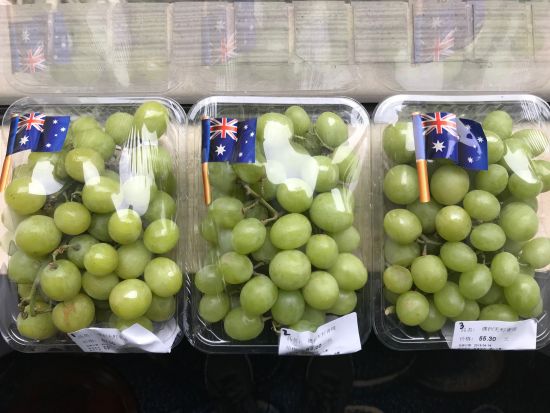
The project will test different types of temperature loggers to determine their practicality and functionality (i.e. ease of use, cost, accuracy, reliability, single use or reusable and if it has SMS/email notifications) that may be of benefit to both growers and exporters.
Materials and Methods
As part of the temperature monitoring component of the SSC project, Agriculture Victoria recently monitored a sea freight container from Australia to China using a Sensitech TempTale® GEO Eagle temperature logger (Figure 1). The advantage of this logger is that it is relatively inexpensive (~ A$75 each) and the shipment information (time, temperature and location data) can be accessed in ‘real-time’ on the cloud-based SensiWatch™ as it contains a 3G-enabled SIM card that works off triangulation with mobile phone towers. Although no data is transferred when the logger is out of range (i.e. at sea), the logger temporarily stores the temperature data so that when it comes back into range the on-line data is updated. The logger was deployed in a carton of Crimson seed less table grapes at a packhouse in Mildura (north-western Victoria) and the route and temperature monitored along the entire trip to Mainland China.
A Sensitech Temptale® GEO Eagle temperature logger (Figure 1) used to monitor a sea freight consignment of Crimson seedless table grapes and its route from Mildura to Adelaide, Fremantle, Singapore and Hong Kong (Figure 2) followed by road transport to Mainland China (Figure 3).
Summary of results and discussion
Tracking
The logger successfully tracked the shipping container and provided updates in Adelaide, Fremantle, Singapore, Hong Kong and China (Figure 1-3, see Methods and Materials). Transit times from Mildura to Hong Kong were approximately 24 days (Figure 4). The temperature profile shows a relatively ‘good’ cool-chain of between 1.0 to 1.5 °C with the occasional temperature spike to approximately 2 °C due to trans-shipping in Fremantle and Singapore.
Air temperatures quickly recovered once power was restored (Figure 4). The larger spike in temperature was attributed to unloading at the port in Hong Kong and the subsequent road transport to the importers warehouse in Guangzhou, China. Ideally, mature table grapes should be stored at a pulp temperature of -1.0 to 0.0 ̊C and 90 to 95% RH which will limit the rate of water loss from fruit stems and help extend shelf life. Therefore, the temperature of the monitored consignment was slightly higher than optimal.

Figure 4. Temperature profile of Crimson Seedless table grapes exported from Mildura to Adelaide, Fremantle, Singapore, Hong Kong and Mainland China.
Inspection
Scientists from Agriculture Victoria inspected another consignment of fruit that was stored at approximately 4 °C for up to 13 days at the importers warehouse. This fruit was part of a packaging trial and had recently been removed from the cool room prior to measuring the grape surface temperature with a handheld infrared digital sensor (Figure 5). Four to five grape bunches were then sub-sampled from multiple cartons and the fruit quality assessed within 24 hours. Soluble solids concentration of grapes as measured with an Atago pocket brix-acidity meter ranged between 22 and 26 °Brix with an acidity level of approximately 1%.
Overall quality of the grapes was generally ‘good’ with only slight browning on the main stem and laterals (Figure 6). Minor scarring and some blemishes were observed on the berries which may deter consumers or result in a less than premium product. Eating quality was mostly ‘good to very good’ due to firm berries, high sugar levels and low acid concentration.
Data gained from these trials will be used to validate predicted changes in table grape quality from models developed in static experiments at Agribio, Bundoora. In these controlled experiments, fruit will be stored under different time and temperature regimes so that response functions can be developed to help predict changes in fruit quality and remaining shelf-life.





